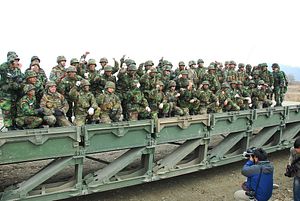My favorite Korean movie growing up was Silmido, a military drama about 31 death row convicts forcibly enlisted into a covert assassination attempt against North Korean President Kim Il-sung.
For two years, the convicts are subjected to grueling physical and mental training. Whether for personal redemption or the promise of freedom, the convicts steadily become an elite group of top-tier special operators, steely-eyed killers with a singular mission. Yet, none of the convicts turned assassins ever cross into North Korea. Through a series of twists, the unit coded named Unit 684 is deemed a liability and subsequently slated for elimination by their military and political handlers. However, members of Unit 684 mutiny on the night of their execution, killing their handlers and escaping the remote island of Silmido. In an ironic twist, the very men trained to kill the North Korean president turn their weapons toward the South Korean president who betrayed their trust and allegiance. The movie ends with a dramatic firefight between Unit 684 and the South Korean military, who have labeled them communist agents.
The military leaves no survivors. All evidence of the covert program is buried and forgotten for decades.
Silmido makes for fantastic drama, but the tragic poignancy of the film stems from the truth behind the plot. The movie, although dramatized, is based on a true and dark episode in Korean history – the Silmido Affair of 1971. (In reality, there were four survivors, who were executed by military tribunal in 1972.)
As a child, I was shocked at the ease with which a government disowned its soldiers, even if they were convicts. Yet, as an adult, I am amazed at the stupidity of the whole affair – particularly the belief that a simple assassination would end the geopolitical stalemate on the Korean peninsula. To add insult to injury, the South Korean government recently announced its plans for a “decapitation unit,” a military euphemism for a squad of assassins, whose singular mission is to target and eliminate strategic North Korean leaders.
The South Korean government argues a swift targeted operation against North Korean leadership will serve as a prepared retaliatory strike against any North Korean provocation, doubling as a deterrent to North Korean nuclear ambitions. The thinking goes, “Cut off the head of the snake and the whole regime falls apart.” The logic is clean, simple, and completely idiotic. This kind of thinking is fortune cookie wisdom masquerading as strategic thought.
History is littered with disastrous, short-sighted assassination and coup attempts – all trying to cut off the head of the snake. In 1961, a paramilitary group of Cubans, sponsored by the CIA, attempted to assassinate Fidel Castro. The Bay of Pigs, as the episode became known, was an utter disaster, subsequently solidifying the hostility between the United States and Cuba and undermining a tenuous Cold War status quo. Similarly, from the 1970s to the 1990s, the CIA-supported Contras of Nicaragua left a trail of terrorist attacks, human rights abuses, and political scandal in their attempt to overthrow the Sandinista government. And let’s not forget more recent episodes of the “decapitation strategy” in Iraq and Afghanistan. Saddam Hussein was executed in 2006, while Osama bin Laden was killed by a team of Navy Seals in 2011. Nevertheless, in both instances, the political order in both countries deteriorated further, spiraling into insurgency and chaos.
The fundamental problem lies in the misguided desire for simple and easy solutions to complex real world problems. For a moment, let’s suspend disbelief and historical evidence, and say that the latest reiteration of South Korea’s assassination squad succeeds in eliminating its targets, including Kim Jong-un. What then? What happens to the roughly 24 million North Koreans currently living in poverty?
It will be foolish to believe reunification of the peninsula will be a smooth transition. Since the cessation of major fighting in 1953, the North and South have diverged dramatically. After the war, South Korea transformed itself into one of the Asian Tigers, riding to economic prominence on the laurels of companies like Samsung and LG. In contrast, the North remained stagnant economically and politically, relegating the Hermit Kingdom to the status of international pariah. As of 2009, the South’s “nominal GNI totaled $837.2 billion, which is 37.4 times larger than the North’s $22.4 billion.” The two countries have deviated so deeply that the languages spoken in the North and South have significantly diverged. According to a 2014 estimate by the South Korean Financial Services Commission (FSC), the cost of reunification would roughly total $500 billion. Admittedly, even this estimate may prove overly optimistic as Germany’s reunification after the Cold War cost roughly $1.5 to $2.5 trillion over 25 years (depending on the source).
The lesson here is that no amount of assassinations will solve the plethora of woes plaguing the Korean peninsula – particularly to the troubles that will inevitably arise in reunification.
For the Korean peninsula, the question should not be how the North’s regime can be eliminated or weakened. The real question lies in how the international community, especially South Korea, should prepare for when the regime fails. The former begets simplistic solutions with short timelines. The latter ponders the long-term consequences and dares to ask the difficult questions.
Let’s leave the simple solutions and neat little endings for the silver screen like Silmido – for reality is far messier and there exists no simple answers. To think otherwise is to invite disaster… again.
Sebastian J. Bae, a columnist for Best Defense at Foreign Policy, served six years in the Marine Corps infantry, leaving as a sergeant. He deployed to Iraq in 2009. Afterwards, he received his masters at Georgetown University’s Security Studies Program, specializing in violent non-state actors and counterinsurgency. He has written for War on the Rocks, Strategy Bridge, Ramen IR, and others. Follow him on Twitter @SebastianBae.































